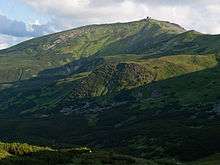Pip Ivan (Chornohora)
Pip Ivan (Ukrainian: Піп Іван; Polish: Pop Iwan) is the third highest peak[1] (after Hoverla and Brebeneskul) of the Chornohora (Czarnohora) range, with height of 2022 meters (6,634 ft) above sea level.[2]

In the interwar period (1918–1939) the peak marked the Polish - Czechoslovak, from March 1939 Polish - Hungarian border and numerous skirmishes between OUN and Polish border troops took place in the area.
On the peak of Chorna Hora (then in Polish called Pop Iwan), the Polish government built in the years 1936–1938 an astronomical and meteorogical observatory, which was commonly called "Biały Słoń" ("White Elephant"). Today, the construction is in ruins.
Now the Chornohora range, is located in Ukraine.
Observatory History
In 1936, the Ministry of Air Defense of Poland laid the first stone to the foundation on the Mount Pip-Ivan.
Stone and wood were brought to the height of 2 028 meters from the neighboring villages and the equipment was brought from all over the world. Hutsuls worked mainly on construction. The scale of the project was enormous, and the working conditions were strenuous: 800 tons of building materials were delivered by train to Vorokhta (70 km from the village to the foot), then the workers had to carry the material on horses and also on their back, including the lifting of loads to the very top. At first, it was necessary to build a high-mountain road.
Engineers have made it possible for researchers and servicemen to stay on the mountain throughout the year. The water pipe was led to the observatory. Since in the winter on the top can lie several meters of snow, and the temperature falls to -40 degrees, the building even had its own heating system - for this purpose, a boiler room was equipped in technical premises.
On the way to Pip-Ivan, the scientists sometimes even fell under avalanche - even in the searches, even the military came out.
The observatory had its own greenhouses, with conditions suitable for growing vegetables.
There were almost no communications from the communications facility.
The thickness of the walls reaches 1.25 m, in order to warm it, the builders put an elongated crust, which was previously delivered there from Africa!.
In July 1938 the observatory was opened. It consisted of the hotel, business premises, and astronomical tower. The hotel had 2 levels on the east side and 5 on the western side. To the tower, where a telescope was later installed, led the transition on the first floor, and upwards mounted screw stairs. On the tower was installed a giant copper, cast dome with a diameter of 10 meters.
The entire building has 43 rooms and 57 windows. Bread was baked directly on the spot, and food stocks had to be renewed only twice a year.
The main equipment of the observatory was the astrograph, whose lens had 33 cm in diameter. Imported from Scotland to Edinburgh. Thanks to the astrograph, scientists were able to study large and small planets, comets, observe and photograph various stars.
The telescope was driven by automatically regulated engines equipped with an ultra-precision timer. The dome of the tower was 6 meters in diameter, and it also had his own electric motors.
With the start of the Second World War, the Observatory began to decline: the research station personnel were urgently evacuated, equipment that was in a position was dismantled and taken away.
In 1939, when Chornohora became a part of the USSR, attempts were made to continue the study of the weather, but in two years, any experimental activity on Pip-Ivan was stopped. Initially, in 1941, the observation point of the Hungarian troops was made on top. Since 1944, the stone voyeur has been left on its own with the passage of time.
The walls of the building are so strong that they have stood for more than 70 years without care and repair: the observation center has almost no internal walls - some were destroyed by people, some of them collapsed on their own. In 2012, the conservation of premises began.
As of 2014, the roof is replaced, floors, strong doors and metal-plastic windows were installed, and fireplace was built. The plans for restoration work include the restoration of a stone fence that previously surrounded the observatory, in order to install solar cells on it, which could electrify the building.
The former Observatory is a popular destination for many tourists.
References
- Ukrayinska Pravda. 7 October 2015 Відновлення покинутої обсерваторії на вершині Карпат триває. ФОТО (Renovation of the abandoned observatory at the Carpathian peak continues).
- Ukraine: The Bradt Travel Guide Andrew Evans - 2007 - 1841621811 Page 247 The mountain town is a good point from which to hike the lower Chornohora (Pip Ivan and Smotrych) and to head off on some walks across the Carpathian countryside. Although not inside the boundaries of the national park, Verkhovyna is the transfer point between buses and taxis to and from Yaremche and Ivano-Frankivsk with Kosiv and Kolomiya. Eight buses go to and from Yaremche every day as well as Kosiv (1 hour).